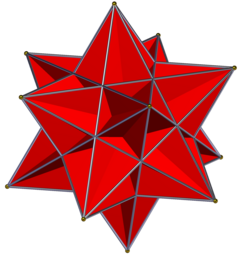Great icosahedron
Appearance
| Great icosahedron | |
|---|---|

| |
| Type | Kepler–Poinsot polyhedron |
| Stellation core | icosahedron |
| Elements | F = 20, E = 30 V = 12 (χ = 2) |
| Faces by sides | 20{3} |
| Schläfli symbol | {3,5⁄2} |
| Face configuration | V(53)/2 |
| Wythoff symbol | 5⁄2 | 2 3 |
| Coxeter diagram | |
| Symmetry group | Ih, H3, [5,3], (*532) |
| References | U53, C69, W41 |
| Properties | Regular nonconvex deltahedron |
 (35)/2 (Vertex figure) |
 Great stellated dodecahedron (dual polyhedron) |
In geometry, the great icosahedron is a Kepler-Poinsot solid. It is one of four nonconvex regular polyhedra. It is composed of 20 triangular faces, with five triangles meeting at each vertex in a pentagrammic sequence.
The 12 vertices match the locations for an icosahedron. The 30 edges are shared by the small stellated dodecahedron.

A transparent model of the great icosahedron (See also Animation)
As a stellation
It is also a stellation of the icosahedron, counted by Wenninger as model [W41] and the 16th of 17 stellations of the icosahedron and 7th of 59 stellations by Coxeter.
The stellation facets for construction are:
References
- Wenninger, Magnus (1974). Polyhedron Models. Cambridge University Press. ISBN 0-521-09859-9.
- Coxeter, H. S. M. (1938). The Fifty-Nine Icosahedra. Springer-Verlag, New York, Berlin, Heidelberg. ISBN 0-387-90770-X.
External links

